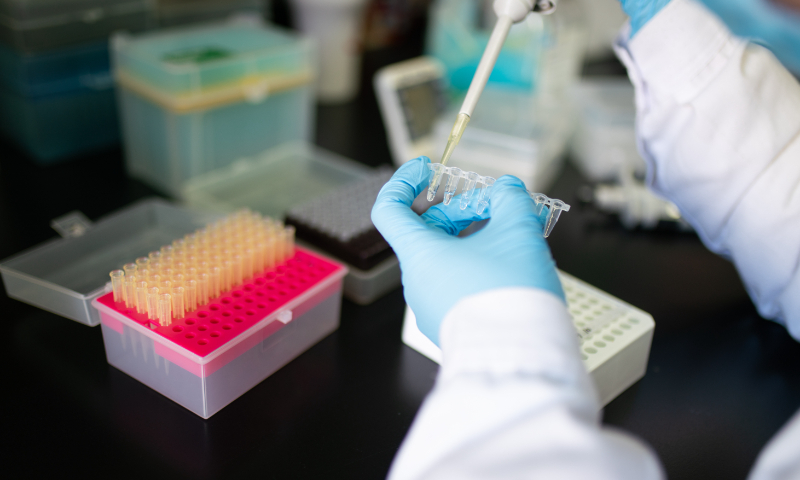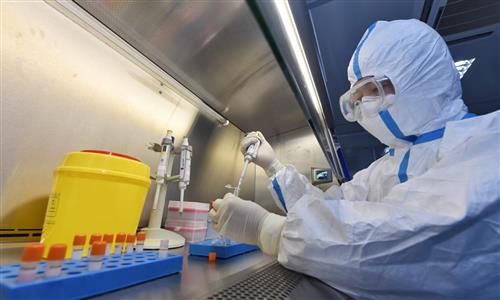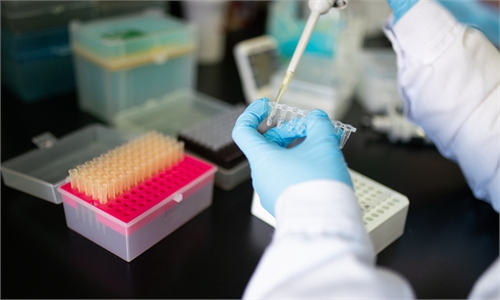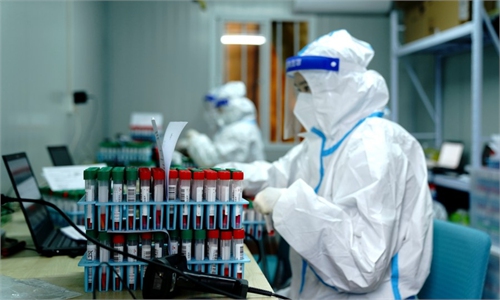SCI-TECH / MEDICINE
Chinese scientists published first study on long COVID at 3 years after primary infection

COVID-19 testing Photo: VCG
Chinese scientists have reportedly published the first study on long COVID, three years after the primary infection.
According to the latest study jointly conducted by teams led by Cao Bin from China-Japan Friendship Hospital and Zhang Dingyu, head of Wuhan Jinyintan Hospital, approximately half of COVID-19 survivors exhibited at least one sequelae symptom after three years from the onset of symptoms.
The most prevalent long COVID symptoms reported were fatigue or muscle weakness, and hair loss. The study, published in The Lancet's respiratory medicine version on December 21, noted that compared with survivors without long COVID, those with long COVID had a higher proportion of re-infection and were more prone to pneumonia after re-infection.
The study highlighted that most long COVID symptoms after three years from onset were mild to moderate, with lung function recovering to levels similar to matched controls.
Survivors with long COVID showed a higher proportion of re-infection and reported newly occurring or worsening symptoms three months after Omicron (B.1.1.529) infection, compared to those without long COVID. Re-infection increased symptom occurrence but did not notably impact reduced daily activity, as mentioned in the study.
While organ function of COVID-19 survivors improved over time, the study's scientists cautioned that individuals with severe long COVID symptoms, abnormal organ function, or limited mobility should receive urgent attention in future clinical practice and research.
Before this study, there were no data on the prevalence of long COVID three years after primary infection, nor evidence on the effects of re-infection in people with long COVID symptoms. Hence, the scientists conducted the study to investigate the three-year health outcomes of COVID-19 survivors and the impact of Omicron re-infection, as detailed in the published paper.
In this single-center, longitudinal cohort study, participants with confirmed COVID-19, discharged from Jinyintan Hospital between January 7 and May 29, 2020, were recruited. Jinyintan Hospital was one of the main hospitals in China's frontline against SARS-CoV-2.
Participants underwent three follow-up visits at 6 months (June 16 to September 13, 2020), 1 year (December 16, 2020, to February 7, 2021), and 2 years (November 16, 2021, to January 10, 2022) post-symptom onset.
At the 1-year follow-up, community controls without a history of SARS-CoV-2 infection were recruited from two Wuhan communities. At the 2-year follow-up, they were matched (1:1) with COVID-19 survivors who underwent pulmonary function tests.
The study conducted a 3-year follow-up from February 23, 2023, to April 20, 2023, after the Omicron wave in winter 2022. Eligible COVID-19 survivors and community controls matched at the 2-year follow-up were invited to the hospital's outpatient clinic for face-to-face questionnaires, a 6-minute walking test (6MWT), and laboratory tests. A subgroup underwent pulmonary function tests, selected based on disease severity scale scores during hospitalization.
Survivors showing abnormal lung images at the 2-year follow-up received another assessment with high-resolution CT. Participants with and without long COVID at 2 years were identified, and the primary outcomes at the 3-year follow-up included sequelae symptoms, Omicron infection, lung function, and chest imaging.
Results revealed that among the 1,359 COVID-19 survivors who completed 2-year and 3-year follow-ups, 728 (54 percent) exhibited at least one sequelae symptom at 3 years post-symptom onset, before Omicron infection, mostly of mild to moderate severity.
During the Omicron wave, participants with long COVID at 2 years had a notably higher proportion of re-infection (573 [76 percent] of 753 vs. 409 [67 percent] of 606 without long COVID) and pneumonia (27 [5 percent] of 568 vs. seven [2 percent] of 403).
Three months after Omicron infection, 126 (62 percent) of 204 survivors with long COVID at 2 years reported newly occurring or worsening symptoms, significantly higher than the non-long COVID group (85 [41 percent] of 205) and community controls (81 [40 percent] of 205). Conversely, no significant difference was found between COVID-19 survivors without long COVID and matched community controls (85 [41 percent] of 205 vs. 81 [39 percent] of 206).
Re-infection emerged as a risk factor for dyspnea, anxiety or depression, and EuroQol visual analogue scale score, but not for reduced daily activity at 3 years. Lung function at 3 years among survivors was similar to that of matched community controls.
At 3 years, irregular lines, traction bronchiectasis, subpleural lines, and ground-glass opacity were observed, but the volume ratio of lung lesion to total lung was only 0.2-0.3 percent.



